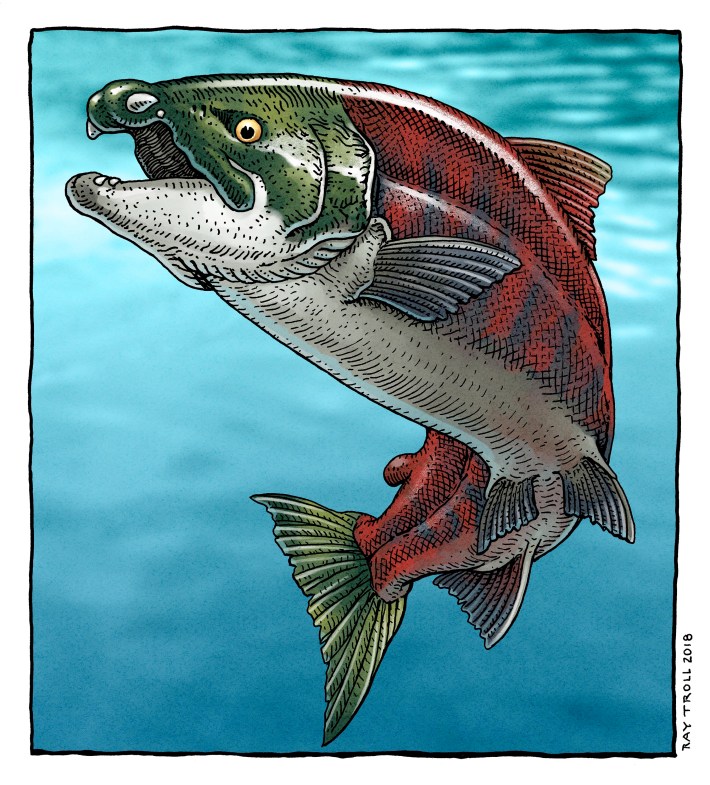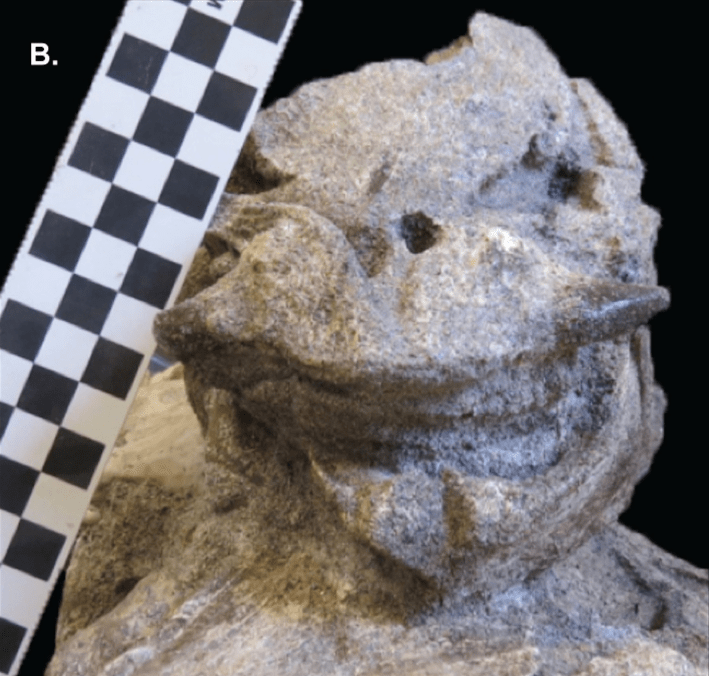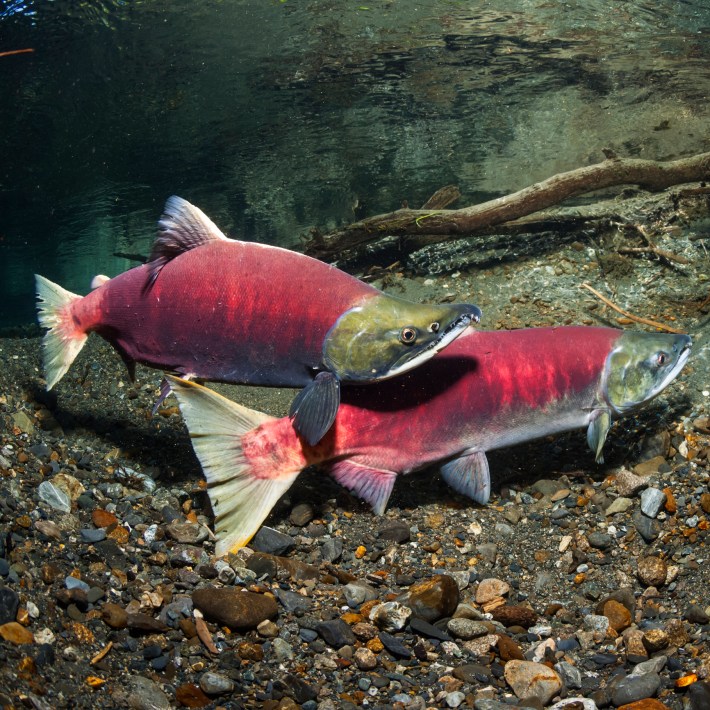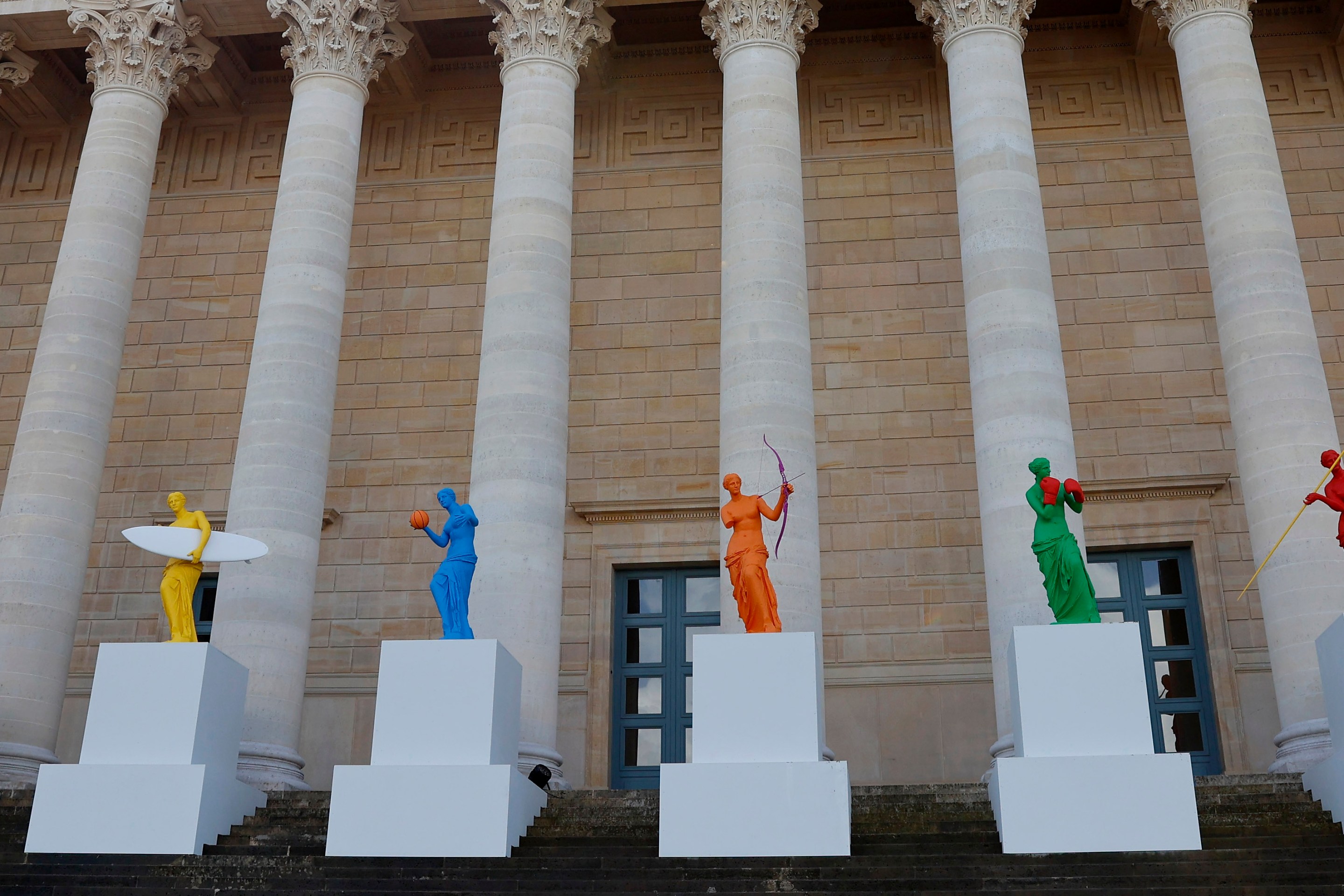In 1964, paleontologists unearthed the skull of a giant ancestor of the sockeye salmon at a quarry near the town of Gateway, Oregon. Some estimate the salmon grew as long as nine feet, making it the largest known salmonid—a family of more than 200 species of fish that include all species of salmon, trout, and taimen—ever to swim on Earth. The paleontologists who unearthed the fossils spotted an enormous tooth on either side of the salmon's jaw. These teeth were fossilized nearby the skull but not connected to it, so the paleontologists guessed the salmon's fangs would have curved downward like those of the saber-toothed tigers in the genus Smilodon, leading them to dub the species Smilodonichthys rastrosus (it would later be renamed Oncorhynchus rastrosus). These reconstructions earned the fish its hardcore nickname, the saber-toothed salmon, and the salmon snarled toothily in reconstructions for decades.
In 1990, the artist Ray Troll had a question. "I was wondering if trout and salmon actually were around in the days of the dinosaurs," he wrote in an email. He reached out to scientists at the University of Washington, asking if salmon lived during the Cretaceous era. "I remember that one said, 'No, but have you heard about this giant prehistoric salmon?'" Troll said. When the scientists sent him the paper describing O. rastrosus, "I just went nuts," Troll said. "It was too good to be true … and almost sounded like a joke." Fish had become his muse since he moved to Alaska nearby a salmon stream, and he started drawing the saber-tooth salmon, eventually traveling to the University of Oregon in Eugene to see the holotype. "They let me take it out on the sidewalk where I sketched out the size of it in chalk," he said.
More than two decades later, Troll painted a mural of the saber-toothed salmon at the University of Oregon's Museum of Natural and Cultural History, in which the salmon bared their teeth alongside saber-toothed tigers. Two months later, he learned that paleontologists had just unearthed two new salmon skulls with even better preservation: This time, the fish's large teeth were attached. But they did not point down like the canines of its feline namesake, but rather protruded outward like those of a warthog or a muntjac. A group of researchers including Troll describe these new fossils and the updated visage of the salmon in a new paper in PLOS One.

When the researchers realized the saber-toothed salmon no longer had saber-teeth, they huddled together to find a new name for the ancient creature. They compiled a short-list and debated the options. "Is it gonna be the tusks? Is it gonna be the horns?" said Kerin Claeson, a paleoichthyologist and anatomist at the Philadelphia College of Osteopathic Medicine and an author on the new paper. Troll had a clear favorite: the spike-toothed salmon. "It rolls off the tongue much easier than some of the other ideas being kicked around and really seemed to describe the teeth well," Troll said. The team agreed, "to honor he who draws the salmon with such prowess, with such glee," Claeson said.
Scientists had known about these two new specimens for several years, but a dangerous rocky overhang prevented them from collecting them. But by 2014, the overhang had eroded enough for them to excavate the fossils and prepare them at the museum. The two fish had been fossilized while touching each other, and the preparers carefully separated them in sections for CT scans. But the salmon's new face was obvious before it went into the machine. "It looks like this fish is smiling at you, and there's these large teeth that are facing outwards," Claeson said.
But fish jaws are not as fixed as human ones. Our teeth are attached to our jawbones, which we move to chew our food. "There are some groups of fish that actually can push their mouths out really far to be able to grasp on to the prey that they want," Claeson said. These fishes' teeth are only loosely associated with their jaws with tissue, which makes them much easier to dislodge or detach in the process of fossilization. "We were trying to see whether or not the hypothesis was correct," Claeson said. "Were they supposed to be in the downward position? Were we looking at something that was maybe deformed during the fossilization?"

The CT scans allowed Claeson to do a digital dissection of the two skulls and discern which fossil fragments were bone, rock, or other tissues. Once she removed the rock from the scans and viewed each bone in isolation, she could see different pieces of tissue that pointed or jutted out in certain ways and understand how they would have been attached to bone. These tissues, which were worn away and absent in the salmon fossils found in 1964, proved the two giant teeth had been fossilized as they appeared in life. When Claeson saw the internal anatomy from the scans, she remembered thinking: “yep, this is absolutely the position that it should be."
The two new salmon fossils were found touching each other within the rock, which Claeson believes means they were fossilized at the same time. The presence of multiple salmon fossils in the area suggests they were all buried rapidly and entombed during a spawning event, she said. "Not quite as sensational, maybe, as what happened to Pompeii's inhabitants that were all covered in ash," Claeson said. "But it's along those lines."
The characteristics of the two fossils' skulls and teeth reveal the two salmon were a male and female, perhaps a mating pair. As modern salmon migrate from the sea to rivers and streams to spawn, their skulls warp to increase their odds at mating. Male sockeye salmon develop a humped back and a hook in their jaws called a kype, and their jaws actually lengthen. "They always remind me a little bit of Gonzo from the Muppets," Claeson said. Female salmon will dig nests in the gravel called redds, and when the nest is complete, the two salmon will swim side by side to spawn. "They're hovering next to one another, essentially," Claeson said. "They let the egg and the sperm go simultaneously, they'll intermingle, and then they'll kind of nestle into this nest." Claeson believes the duo were spawning at the time of their fossilization. "They're so close to one another," she said.

A 2016 paper in the journal PaleoBios suggested the spike-toothed salmon experienced similar developmental changes during their breeding season, as salmon specimens from freshwater deposits had the biggest teeth with the most battered tooth tips, suggesting the salmon used their tusks to defend territories and construct nests for spawning. O. rastrosus did not use its spiky teeth for feeding, as their fossils reveal evidence of sieve-like gill rakers that would have allowed the fish to feed on plankton. But the new paper speculates that the spike-toothed salmon also used its big teeth as weapons to attack or defend themselves from other fish, in addition to nest-building. Many modern fish, such as sawfish, have bodily protrusions that can serve multiple purposes.
Claeson and colleagues first published the news of their "facelift" of this famously saber-toothed salmon at a conference in 2016, which has led to some revisions in the fish's many modern incarnations. The sculptor Gary Staab sawed off the saber-teeth of his six-foot-long salmon sculpture and reattached them on the sides of the salmon's head. In the same museum, Troll's salmon mural remains unchanged. "It’s up to the museum staff to decide, but I think the idea is to leave it as is to reflect how science changes as new discoveries are made," Troll said. "It reflects our understanding at the time." So Troll's saber-toothed salmon will remain fanged and snarling into the future, a relic of the past just like his fishy muse.
If you liked this blog, please share it! Your referrals help Defector reach new readers, and those new readers always get a few free blogs before encountering our paywall.
Stay in touch
Sign up for our free newsletter





